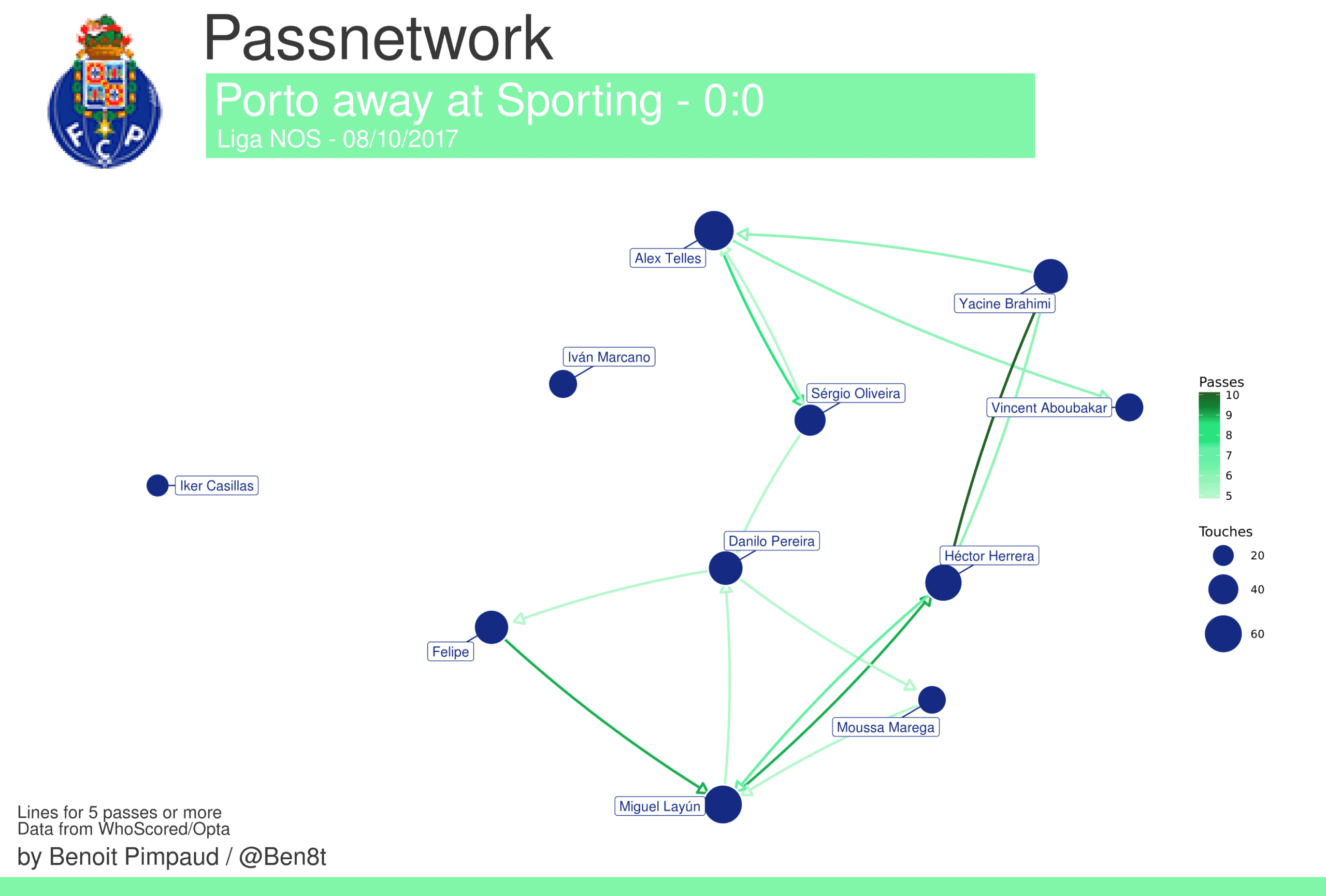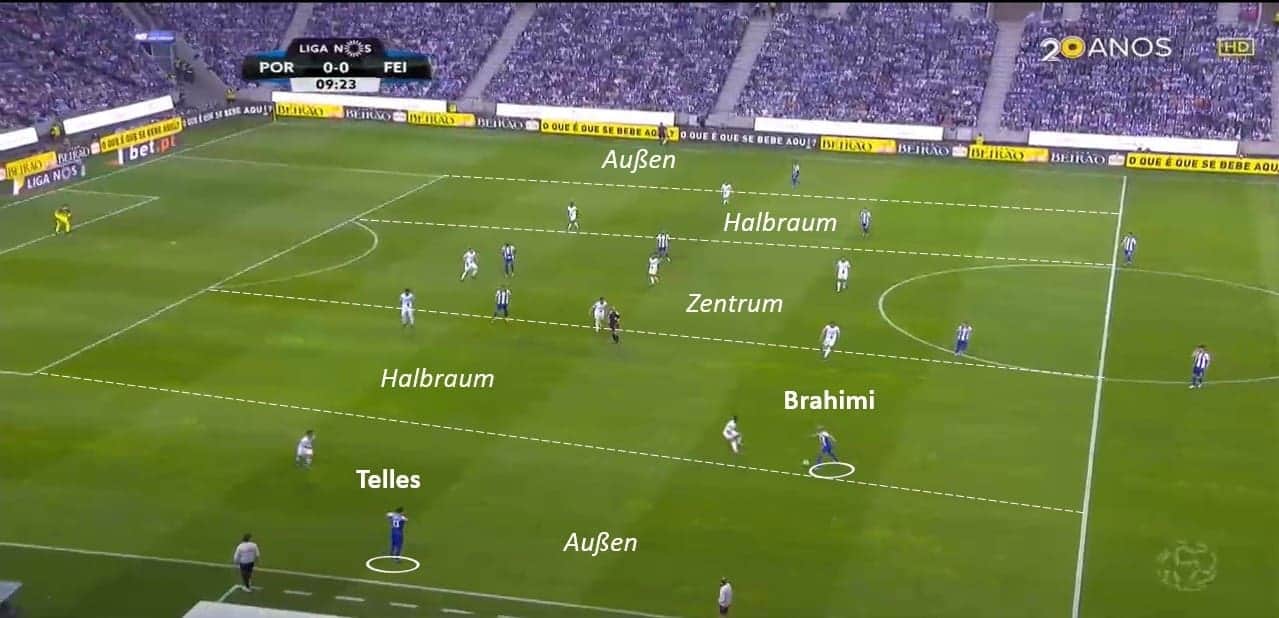Under Sergio Conceição’s tactics, FC Porto won their first Primeira league title since 2013.
For Conceição, who is coming off a great job he did with Nantes in Ligue 1, this is another impressive result to add to his young coaching career.
Other well-regarded managers, such as Paulo Fonseca, Nuno Espirito Santo, or current Spain coach Julen Lopetegui, tried but failed to achieve the league title as Conceição did.
Porto’s tactical organisation
The main feature of Sergio Conceição’s coaching style at Porto is flexibility.
The former Lazios midfielder switched his side approach based on the game or opponent.
Generally speaking, Conceição’s Porto has been built around a 4-4-2 with Vincent Aboubakar and Moussa Marega up top.
To maintain defensive compactness, Conceição often opted to play with three central midfielders and two wingers in a 4-5-1/4-1-4-1 system, with Danilo acting as a midfield sweeper.

The pass map provided by @Ben8t highlights the lone striker formation lined up by Conceição against Sporting CP.
The four-man backline has played a pivotal role in Porto’s seasonal success.
Ricardo Pereira on the right and Alex Telles on the left are the full-backs.
Both are skilled footballers able to push high up the pitch, acting as wingbacks when Conceição’s side is in possession.
They are technically gifted: The 24-year-old Pereira registered 80.3% pass success, also adding two goals and four assists.
For his part, Brazilian Telles accounted for 83% of pass success, scoring three goals and producing an impressive twelve assists.
The centre-back duo features Brazilian Felipe paired with Iván Marcano.
Both are suited with the ball at their feet, with Felipe recording an 83.1% pass success rate whilst the Spaniard Marcano produced an 82.5% in the same category.
In the middle between Aboubakar and Marega and the backline, Conceição usually lined up a four-man midfield featuring Yacine Brahimi and Jesús Manuel Corona as wingers.
The Mexican Corona—who already made a lot of buzz when playing in Eredivisie with Twente some seasons ago—netted three goals and three assists, while the 28-year-old Algerian Brahimi scored nine league goals and added seven assists.
The central midfield duo features two between Héctor Herrera, Sérgio Oliveira and Danilo Pereira.
Sergio Conceição Offensive Tactics
From an offensive point of view, the critical aspect of Sergio Conceição’s manager style is to have both wingers play inside their respective centre-half while the full-backs have the freedom to push higher up the pitch.
These offensive movements give Brahimi and Corona freedom to roam up top and link the play between the midfield and Aboubakar and Marega.
This pattern allowed Porto to disorganise and manipulate the opposition’s defensive structure.
Brahimi is particularly able to do it.
He completed as many as 5.2 dribbling per game allowing Porto to create numerical superiority.

Conceição’s positional play. Take a look at Brahimi’s inside position, which leaves Telles free to occupy the wider left channel.
But the aforementioned movement also reduces the spaces both Aboubakar and Marega have to cover up top.
In fact, both forwards are instructed to stay inside the middle channel and the half-spaces in order to minimise their energetic expenditure.
Coming to the defensive phase of the game, Porto is mainly focused when playing without the ball.
The central aspect of Sergio Conceição’s style of play defensively is the attempt to reduce the space around the opposite ball carrier.
It happens playing an aggressive high-pressure involving both strikers and the flankers.
The goals there are attempts to manipulate rivals’ building up by forcing defenders or the goalkeeper to play long balls that can be easily recovered by Porto’s centre-backs or to immediately win the ball back into a more advanced area of the field.
It has also been not unusual to see an interior midfielder accompany the forwards up top in the pressing action, with the remaining midfielders positioning themselves to cover the channels in the middle of the park.
Obviously, this is a risky tactic.
In fact, as even happens with the side playing high-pressing, should the opposite team bypass Porto’s first line of pressure, they would have a lot of space to exploit in front of them.
It means Conceição put a lot of emphasis on his team approach during defensive transitions.
They require Porto’s players to recover their position as soon as possible.
This approach is deeply demanding for Conceição’s backline, as they need to stay focused to correctly read ball open situations in which the four-man defence has to collapse behind to prevent opponents from gaining space at their back.
With opponents defending through a low block, Porto has always been dangerous, providing nice crosses from the outside. The inside movements of both flankers inside the half-spaces allowed full-backs to receive the ball with space and time to deliver these crosses.
That said, Conceição showed his flexibility once again when it came to playing in the Champions League against better and stronger opponents.
In this case, the coach asked his team to be able to defend deep in their own territory, also giving them the freedom to play long and direct balls up top to avoid the opposite’s offensive pressure.
Conclusion
After his brilliant Ligue 1 experience, Conceição was able to repeat his success in Portugal, showing that he was flexible enough to adapt his side according to the level of the opposite team.
The compromise between his football philosophy and the game Porto had to play and Conceição’s attention to the details make former Portugal international another Portuguese coach to take a look to next seasons.





Comments